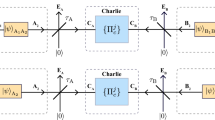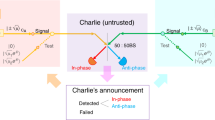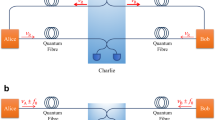Abstract
Quantum key distribution (QKD)1,2 allows two distant parties to share encryption keys with security based on physical laws. Experimentally, QKD has been implemented via optical means, achieving key rates of 1.26 megabits per second over 50 kilometres of standard optical fibre3 and of 1.16 bits per hour over 404 kilometres of ultralow-loss fibre in a measurement-device-independent configuration4. Increasing the bit rate and range of QKD is a formidable, but important, challenge. A related target, which is currently considered to be unfeasible without quantum repeaters5,6,7, is overcoming the fundamental rate–distance limit of QKD8. This limit defines the maximum possible secret key rate that two parties can distil at a given distance using QKD and is quantified by the secret-key capacity of the quantum channel9 that connects the parties. Here we introduce an alternative scheme for QKD whereby pairs of phase-randomized optical fields are first generated at two distant locations and then combined at a central measuring station. Fields imparted with the same random phase are ‘twins’ and can be used to distil a quantum key. The key rate of this twin-field QKD exhibits the same dependence on distance as does a quantum repeater, scaling with the square-root of the channel transmittance, irrespective of who (malicious or otherwise) is in control of the measuring station. However, unlike schemes that involve quantum repeaters, ours is feasible with current technology and presents manageable levels of noise even on 550 kilometres of standard optical fibre. This scheme is a promising step towards overcoming the rate–distance limit of QKD and greatly extending the range of secure quantum communications.
This is a preview of subscription content, access via your institution
Access options
Access Nature and 54 other Nature Portfolio journals
Get Nature+, our best-value online-access subscription
$29.99 / 30 days
cancel any time
Subscribe to this journal
Receive 51 print issues and online access
$199.00 per year
only $3.90 per issue
Buy this article
- Purchase on Springer Link
- Instant access to full article PDF
Prices may be subject to local taxes which are calculated during checkout



Similar content being viewed by others
References
Bennett, C. H. & Brassard, G. Quantum cryptography: public key distribution and coin tossing. Theor. Comput. Sci. 560, 7–11 (2014).
Ekert, A. K. Quantum cryptography based on Bell’s theorem. Phys. Rev. Lett. 67, 661–663 (1991).
Comandar, L. C. et al. Room temperature single-photon detectors for high bit rate quantum key distribution. Appl. Phys. Lett. 104, 021101 (2014).
Yin, H.-L. et al. Measurement-device-independent quantum key distribution over a 404 km optical fiber. Phys. Rev. Lett. 117, 190501 (2016).
Briegel, H.-J., Dür, W., Cirac, J. I. & Zoller, P. Quantum repeaters: the role of imperfect local operations in quantum communication. Phys. Rev. Lett. 81, 5932–5935 (1998).
Duan, L.-M., Lukin, M. D., Cirac, J. I. & Zoller, P. Long-distance quantum communication with atomic ensembles and linear optics. Nature 414, 413–418 (2001).
Sangouard, N., Simon, C., de Riedmatten, H. & Gisin, N. Quantum repeaters based on atomic ensembles and linear optics. Rev. Mod. Phys. 83, 33–80 (2011).
Takeoka, M., Guha, S. & Wilde, M. M. Fundamental rate-loss tradeoff for optical quantum key distribution. Nat. Commun. 5, 5235 (2014).
Pirandola, S., Laurenza, R., Ottaviani, C. & Banchi, L. Fundamental limits of repeaterless quantum communications. Nat. Commun. 8, 15043 (2017).
Jiang, L. et al. Quantum repeater with encoding. Phys. Rev. A 79, 032325 (2009).
Munro, W. J., Stephens, A. M., Devitt, S. J., Harrison, K. A. & Nemoto, K. Quantum communication without the necessity of quantum memories. Nat. Photon. 6, 777–781 (2012).
Azuma, K., Tamaki, K. & Lo, H.-K. All-photonic quantum repeaters. Nat. Commun. 6, 6787 (2015).
Azuma, K., Tamaki, K. & Munro, W. J. All-photonic intercity quantum key distribution. Nat. Commun. 6, 10171 (2015).
Qiu, J. Quantum communications leap out of the lab. Nature 508, 441–442 (2014).
Yin, J. et al. Satellite-based entanglement distribution over 1200 kilometers. Science 356, 1140–1144 (2017).
Pirandola, S. Capacities of repeater-assisted quantum communications. Preprint at https://arxiv.org/abs/1601.00966 (2016).
Pfleegor, R. L. & Mandel, L. Interference of independent photon beams. Phys. Rev. 159, 1084–1088 (1967).
Tamaki, K., Lo, H.-K., Fung, C.-H. F. & Qi, B. Phase encoding schemes for measurement-device-independent quantum key distribution with basis-dependent flaw. Phys. Rev. A 85, 042307 (2012).
Bovino, F. A. & Messina, A. Increasing operational command and control security by the implementation of device independent quantum key distribution. Proc. SPIE 9996, 999606 (2016).
Hwang, W.-Y. Quantum key distribution with high loss: toward global secure communication. Phys. Rev. Lett. 91, 057901 (2003).
Wang, X.-B. Beating the photon-number-splitting attack in practical quantum cryptography. Phys. Rev. Lett. 94, 230503 (2005).
Lo, H.-K., Ma, X. & Chen, K. Decoy state quantum key distribution. Phys. Rev. Lett. 94, 230504 (2005).
Lo, H.-K., Curty, M. & Qi, B. Measurement-device-independent quantum key distribution. Phys. Rev. Lett. 108, 130503 (2012).
Ma, X. & Razavi, M. Alternative schemes for measurement-device-independent quantum key distribution. Phys. Rev. A 86, 062319 (2012).
Gottesman, D., Lo, H.-K., Lütkenhaus, N. & Preskill, J. Security of quantum key distribution with imperfect devices. Quantum Inf. Comput. 4, 325–360 (2004).
Lo, H.-K., Chau, H. F. & Ardehali, M. Efficient quantum key distribution scheme and a proof of its unconditional security. J. Cryptol. 18, 133–165 (2005).
Santarelli, G., Clairon, A., Lea, S. & Tino, G. Heterodyne optical phase-locking of extended-cavity semiconductor lasers at 9 GHz. Opt. Commun. 104, 339–344 (1994).
Appel, J., MacRae, A. & Lvovsky, A. I. A versatile digital GHz phase lock for external cavity diode lasers. Meas. Sci. Technol. 20, 055302 (2009).
Lipka, M., Parniak, M. & Wasilewski, W. Optical frequency locked loop for long-term stabilization of broad-line DFB lasers frequency difference. Appl. Phys. B 123, 238–245 (2017).
Minář, J., de Riedmatten, H., Simon, C., Zbinden, H. & Gisin, N. Phase-noise measurements in long-fiber interferometers for quantum-repeater applications. Phys. Rev. A 77, 052325 (2008).
Acknowledgements
We acknowledge K. Tamaki for constructive criticism on the security argument. We acknowledge discussions with X. Ma, N. Lütkenhaus, B. Fröhlich, R. M. Stevenson, D. G. Marangon and A. J. Bennett.
Reviewer Information
Nature thanks X. Ma and the other anonymous reviewer(s) for their contribution to the peer review of this work.
Author information
Authors and Affiliations
Contributions
M.L. and Z.L.Y. developed the TF-QKD scheme. Z.L.Y. and J.F.D. set up and performed the experiments, and all authors analysed the results. A.J.S. guided the work. M.L. wrote the manuscript with contributions from all authors.
Corresponding author
Ethics declarations
Competing interests
The authors declare no competing interests.
Additional information
Publisher’s note: Springer Nature remains neutral with regard to jurisdictional claims in published maps and institutional affiliations.
Supplementary information
Supplementary Information
This file contains the following sections: Fibre-based experiments; Protocol; Active feedback; Numerical simulations; Security argument; Notation; Reduction to a BB84-like scheme; Single-photon source; Actual schemes; Entanglement distillation and virtual schemes; Weak-coherent-pulse source; Dropping the assumption on random phase announcement; Collective beam-splitting attack; Considerations on the key rates in Fig. S3; Final considerations; and References.
Rights and permissions
About this article
Cite this article
Lucamarini, M., Yuan, Z.L., Dynes, J.F. et al. Overcoming the rate–distance limit of quantum key distribution without quantum repeaters. Nature 557, 400–403 (2018). https://doi.org/10.1038/s41586-018-0066-6
Received:
Accepted:
Published:
Issue Date:
DOI: https://doi.org/10.1038/s41586-018-0066-6
This article is cited by
-
On the (relation between) efficiency and secret key rate of QKD
Scientific Reports (2024)
-
Controlling the photon number coherence of solid-state quantum light sources for quantum cryptography
npj Quantum Information (2024)
-
Improving the performance of practical phase-matching quantum key distribution with advantage distillation
Quantum Information Processing (2024)
-
Withstanding detector attacks in continuous-variable quantum key distribution via mean-restricted unary linear regression
Quantum Information Processing (2024)
-
Efficient information reconciliation in quantum key distribution systems using informed design of non-binary LDPC codes
Quantum Information Processing (2024)
Comments
By submitting a comment you agree to abide by our Terms and Community Guidelines. If you find something abusive or that does not comply with our terms or guidelines please flag it as inappropriate.



